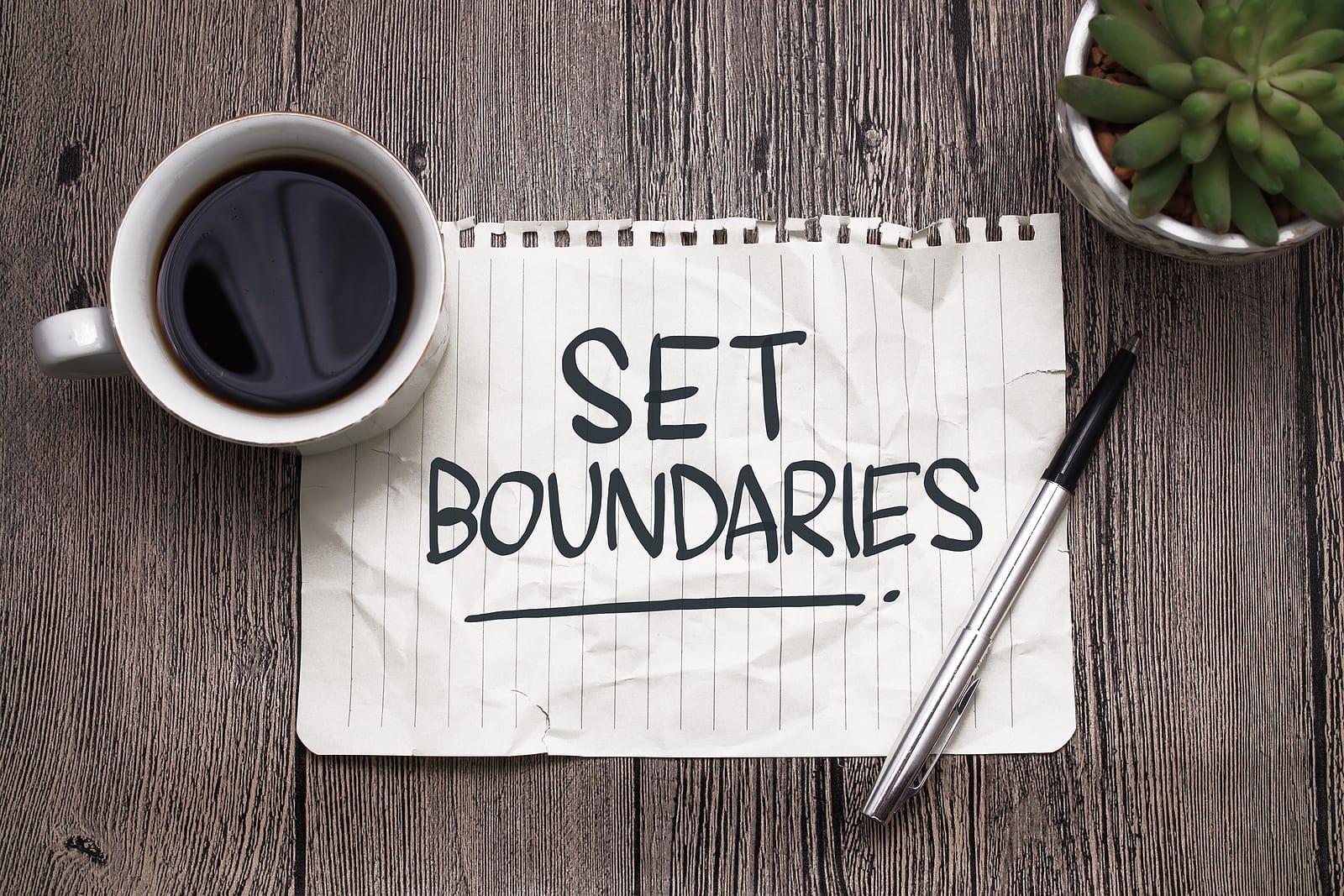5 Steps to Creating and Maintaining Healthy Boundaries
Having healthy boundaries is key for preserving your mental and emotional health, but boundaries in relationships can seem confusing and hard to define at times, since they are invisible, abstract, and change over time. So, what do boundaries look like? And more importantly, how can we set and maintain healthy boundaries in our lives?
What are Boundaries?
If you think about boundary lines on a map, separating one state from another, or an invisible fence that separates your yard from your neighbor’s, boundaries define where you end and another person begins. Boundaries are where you draw the line between yourself and others; so that if you feel like someone has “crossed the line,” this probably means that they overstepped a boundary. In other words, boundaries function like rules in a relationship, determining what you are willing and not willing to tolerate.
Healthy boundaries are limits you set around your time, emotions, psychological energy, and physical space and body to protect yourself from feeling drained by others in your life. For instance, a healthy boundary at work may be saying no to a project that would cause you to work late after-hours and interfere with self-care and a work-life balance.
For that reason, healthy boundaries promote good mental and emotional health and help you avoid burnout, exhaustion, and resentment.
What does it look like if we don’t set healthy boundaries in our life?
What are Unhealthy Boundaries?
Unhealthy boundaries can sometimes feel like others are taking advantage of you or your time. If you find that you’re overextending yourself in your relationships, overcommitting your time to others and having little time to yourself, it may signal a lack of boundaries. Unhealthy boundaries can also look like having a hard time saying no to others, putting others’ needs and wants before your own, taking on others’ problems or responsibilities as your own, or feeling exhausted or burnt out by overwhelming commitments. If these sound like they hit home for you, it may be time to start practicing setting healthy boundaries in your life. This can feel like a hard shift, since for a lot of people, having unhealthy boundaries can mean a habit of always saying yes, followed by regret, dread, and resentment.
A helpful way to think about setting boundaries is that when you set a healthy boundary, you may feel guilty for a short time, but the alternative is feeling resentful for a long time.
“When you feel yourself becoming angry, resentful or exhausted, pay attention to where you haven’t set a healthy boundary.” – Crystal Andrus Morissette, author of The Emotional Edge
How to Set Boundaries
Setting boundaries communicates what you are willing to say yes to and what you decide to say no to. They give you power over your decisions, time, and emotions, rather than these being dictated by others. Here are some steps to establishing, setting, and maintain healthy boundaries.
1. IDENTIFY YOUR LIMITS
For some of us, we may not even know that a boundary has been crossed or a limit overstepped until after the fact. It can be hard to know for yourself where that line is. The first step to setting boundaries is to identify what your limits are. Some useful questions to ask yourself can be: Where am I overextending myself in my life? What areas of my life do I feel drained by? What commitments do I feel obligated to, yet exhaust me? What is causing me unnecessary stress, discomfort, or dread? The key to identifying your limits and boundaries is to listen to your gut reaction of whether you have the time or energy to commit to something or if you need to say no. Setting aside time to reflect on moments in the past when a boundary wasn’t set or when someone crossed a boundary can help you to intuitively define where your limits are for the next time.
2. CLEARLY COMMUNICATE YOUR BOUNDARIES
Once you’ve gotten an understanding of some concrete and specific boundaries you’d like to set in your life, the next step to establishing healthy boundaries is to assertively communicate them to others. A common mistake to avoid is to assume that others automatically know your limits. If you don’t clearly and directly communicate a boundary, how will others know when they’ve crossed it?
Communicating your needs and limits is a vital step to having healthy boundaries and preserving your personal space and emotional energy. However, if you’re not used to setting clear boundaries, it may feel uncomfortable or even rude for you to start doing so. Not only is it important to express these boundaries in a clear, direct, and assertive way, but it is also necessary to find a way to communicate them in a way that feels authentic to you. So, finding a straightforward and kind way to assertively communicate your needs is key to being able to set and keep these boundaries.
For example, if a friend or family member asks you for a favor that you don’t have the time or energy for, you can politely decline, saying, “I’d like to be able to help you out with that this weekend, but unfortunately I’m not going to be able to make it work.”
Sometimes it can be wise to let someone know of a boundary at the outset of plans, especially when it comes to boundaries around your time. If you have a phone call or in-person plans with a friend who you know expects more of your time than you feel able to give, letting them know ahead of time by saying, “It’s nice to get to talk to you. I’m going to have to hop off the phone in 20 minutes to get some other things done here,” or “I’m looking forward to your party. I wanted to give you a heads up that I can only stay for an hour.” This way you’ve preemptively let them know where your limits are and what they can expect from you.
3. PRACTICE WHAT YOU WANT TO SAY: OFFERING AN ALTERNATIVE OR ASKING FOR MORE TIME CAN HELP.
Practicing what you want to say and how to say it will increase your chances of successfully setting a boundary. Of course we can’t anticipate every overbearing request or boundary crossing and how to respond flawlessly, but you can think about the people and situations in your life where you often feel pressured to say yes or overextend yourself. Knowing how you want to communicate your needs and limits ahead of time (and again, in a way that feels authentic to you!) will make it more likely that you’ll be able to say it in the moment.
If saying no seems like a difficult new habit to build, especially if you’re not used to declining people’s requests, it can help to suggest an alternative plan in which both your and the other person’s needs will be met. For example, “I have a lot on my plate right now at work but maybe I can help with the next project,” or “Unfortunately I won’t be able to help you move that day. If it would be helpful to you, I can come over on Saturday and help you pack instead.” Be careful to make sure that the alternative that you offer still remains within what you’re able to give.
Sometimes a request can catch us off-guard and if you’re used to saying yes to people in your life, you may not have enough time to figure out how to say no in the moment. A helpful strategy for these unexpected instances can be to practice saying, “let me get back to you.” You can say that you have to check your schedule, your to-do list, or check in with your significant other. This will give you some time to decide how you’d like to respond if you’re feeling pressured in the moment. Then you can respond through email or text with a polite no.
4. AVOID OVERAPOLOGIZING OR OVEREXPLAINING
Especially if you’re not used to saying no or setting firm boundaries in your relationships, it can feel like a daunting and overwhelming task. In an effort to be polite and avoid seeming rude, some people can fall into a tendency to apologize profusely or overexplain the reason why they’re setting a limit. But in actuality, saying no doesn’t have to be rude, and it also doesn’t require an apology or explanation. Notice if you tend to fall into these patterns. It can be helpful to explore why you feel the urge to offer long-winded reasoning or say sorry multiple times. Are feelings of guilt or not feeling deserving feeding into this pattern? What does setting a boundary represent to you? If you do find yourself wanting to apologize again or offer more reasoning, it can be even more important to practice what you’ll say in order to set and keep a boundary. While you may need to repeat yourself a few times, don’t feel the need to apologize or explain your boundaries.
5. BE CONSISTENT WITH YOUR BOUNDARIES
What if someone does not respond positively to your assertiveness? When setting boundaries, it is important to stand your ground and be consistent with your original decision. Especially if you’re setting boundaries with a family member, friend, or coworker for the first time, it might be helpful to prepare how to respond if they push back. You can acknowledge their disappointment by saying, “I know it must be disappointing to you that I can’t help you move, but unfortunately, I can’t make it work.” Again, you can offer an alternative plan or something along the lines of, “maybe next time.”
You may have a sense of who in your life may not accept you saying no the first time. If you’ve told a coworker, “I can’t help out with that project at work” and they respond with, “But you’re great at this! It shouldn’t take too much of your time,” how might you respond? One response that stands firm with the boundary could be, “Thanks for the offer. I’m not going to be able to take it on given my other responsibilities right now but maybe the next one.”
Sticking to your initial response helps communicate to them that this is a boundary that they can’t easily cross and encourages them to take your limits seriously. The firmer you are with your boundaries, the more likely your boundaries will be respected.
Again, practice, practice, practice.
IMPORTANT TIPS TO KEEP IN MIND WHEN SETTING BOUNDARIES:
- Listen to your gut – it will help you know your limits.
- Use clear, direct communication.
- Avoid over apologizing and overexplaining.
- PRACTICE!
- Remember that you’re choosing between feeling guilty for a short-time or resentful for a long-time.
Call to Talk to a Therapist Today!
Dr. Mona Khaled specializes in trauma therapy and healthy boundary setting. Give her a call at (310) 453-8788 or fill out a contact form to speak with Dr. Mona today so you can learn more about how therapy can help you have healthier relationships with yourself and others.

